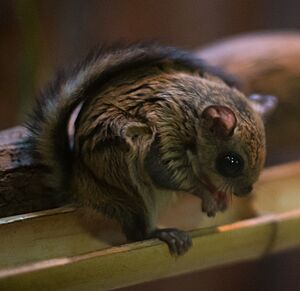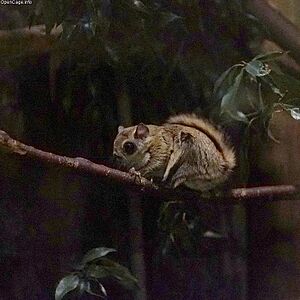Japanese dwarf flying squirrel facts for kids
Quick facts for kids Japanese dwarf flying squirrel |
|
|---|---|
 |
|
| Conservation status | |
| Scientific classification | |
| Genus: |
Pteromys
|
| Species: |
momonga
|
The Japanese dwarf flying squirrel (scientific name: Pteromys momonga) is a super cute animal! It's a type of flying squirrel found in Japan. During the day, this little squirrel sleeps hidden in a tree hole, often in a pine or spruce tree. When night comes, it wakes up and goes out to find food.
Contents
About the Japanese Dwarf Flying Squirrel

This squirrel is quite small. Its body is about 14 to 20 centimeters (5.5 to 8 inches) long. Its tail adds another 10 to 14 centimeters (4 to 5.5 inches) to its length. It weighs between 150 and 220 grams (about 5 to 8 ounces). That's much smaller than its cousin, the Japanese giant flying squirrel, which can weigh up to 1500 grams!
The Japanese dwarf flying squirrel has soft, grey-brown fur on its back. Its belly is white. It has big, round eyes that help it see in the dark. Its tail is flat, which helps it balance.
How They Fly
Flying squirrels don't actually fly like birds. Instead, they glide! They have a special skin flap called a patagium. This membrane stretches between their wrists and ankles. When they spread their limbs, the patagium acts like a parachute or a wingsuit. This allows them to glide smoothly from one tree to another.
Where They Live
These squirrels live in the forests of Japan. You can find them on the islands of Honshu, Kyushu, and Shikoku. They prefer sub-alpine forests and evergreen forests.
Their Homes
Japanese dwarf flying squirrels build their nests inside tree holes. They also like to nest where branches meet the tree trunk. They make their nests cozy by lining them with soft mosses and lichens. Tree cavities are very important for them to have a safe place to live. They often choose conifer trees, like pine and spruce, for their homes.
Daily Life and Habits
What They Eat
The Japanese dwarf flying squirrel is a nocturnal animal. This means it is active at night and rests during the day. It eats many different things found in the forest. Its diet includes seeds, fruits, tree leaves, buds, and tree bark.
When it's time to eat, the squirrel often hangs upside down. If a twig with food is too thin to hold its weight, it will pull the twig closer with its front paws. If food is scattered on the ground, it can reach for it without moving its back legs.
Social Life
Sometimes, you might see several Japanese dwarf flying squirrels together in one tree. However, outside of mating season, these groups are usually made up of squirrels of the same sex. During mating season, a male and female pair might share a nest.
Reproduction and Life Cycle
These squirrels usually mate twice a year. This happens between May and July. After mating, the mother squirrel is pregnant for about four weeks. A mother squirrel typically gives birth to two or three babies at a time. Sometimes, she can have up to five young. The baby squirrels grow up quickly and are ready to be on their own by about six weeks old.
Who Are Their Predators?
Japanese dwarf flying squirrels have several natural enemies. These include raccoons, hawks, owls, foxes, weasels, and bobcats. Even house cats can sometimes hunt these small squirrels.
Conservation Status
The number of Japanese dwarf flying squirrels in the wild is not precisely known. However, the International Union for Conservation of Nature (IUCN) lists them as a "least-concern species". This means they are not currently in danger of disappearing. They live in many protected areas and are quite common in their habitat.
See also
 In Spanish: Ardilla voladora de Japón para niños
In Spanish: Ardilla voladora de Japón para niños


